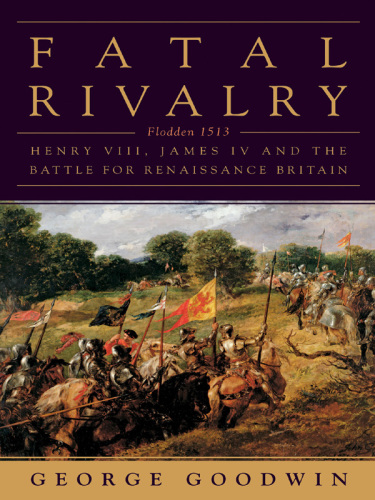
Fatal Rivalry
Flodden, 1513: Henry VIII and James IV and the Decisive Battle for Renaissance Britain
- اطلاعات
- نقد و بررسی
- دیدگاه کاربران
نقد و بررسی

June 17, 2013
Much has been written about Mary, Queen of Scots, and the rivalry between her and her cousin, Elizabeth I of England, which ended in Mary’s execution. But this was not the only fraught relationship between a 16th-century Scottish monarch and an English one that culminated in bloodshed. British historian Goodwin (Fatal Colours: Towton 1461) explores an earlier rivalry that played an influential role in the conglomeration of Great Britain 200 years later. While England’s Henry VII sought to keep the peace, even giving his daughter Margaret in marriage to Scotland’s James IV, Henry VIII took the English throne in 1509 as a teenager eager for glory. The monarchic brothers-in-law had much in common, and both were “masters of majestic display,” argues Goodwin, but while the more mature James regarded the display of might as “a substitute for war,” Henry regarded it as preparation for battle. Goodwin’s detailed account of the events leading up to the clash at Flodden on Sept. 9, 1513, places James at the center of the story, and it provides a fresh and provocative take on the intertwined histories of Tudor England and Stuart Scotland. 8 pages of color, 8 pages of b&w illus.

July 15, 2013
In this account of a pivotal battle in Scottish history, Goodwin (Fatal Colours: Towton 1461--England's Most Brutal Battle, 2012, etc.) demonstrates that he understands that history is much more interesting in small bites. This is the tale of two monarchs, brothers-in-law, one strong, one strong-headed, who were fated to clash. Henry VIII of England had entirely different views of war from than those of his father. The elder looked to the joust and tournaments as a substitute for war, while Henry VIII, banned from jousting when he became Prince of Wales upon his brother's death, craved the acclaim of battlefield success. James IV was king of Scots, father to all; the Scots looked to him for direction and impartial decisions while they unquestionably supported his call to arms. Goodwin provides a short background history while deftly describing James and Henry--with considerably less material available on James. The author is not especially friendly to Henry, portraying him more as a spoiled child than a princely leader. The real story is of the clash at Flodden a mere four years after Henry's accession. Henry was actually off in France trying to emulate Henry V, and it was the Lord Howard, Earl of Surrey, who fought with his one-time friend, James, at Flodden in 1513. The author's descriptions of the battle are excellent, without too many obscure details that usually just confuse the narrative. The importance of this battle cannot be overstated: It was the last medieval battle fought with pikes and the first modern one fought with artillery; it was also the beginning of the end of Scottish independence. A swift, enjoyable treatment of one of the most significant battles of the period.
COPYRIGHT(2013) Kirkus Reviews, ALL RIGHTS RESERVED.

July 1, 2013
Five hundred years ago, the armies of James IV of Scotland and Henry VIII of England engaged in a decisive battle in northern England. The battle on Flodden Field was one of the bloodiest fought on British soil and the culmination of more than two centuries of intermittent warfare between the two kingdoms. The English victory guaranteed English domination of the British Isles and pointed the way to the eventual formal union of England and Scotland two centuries later. Goodwin provides a concise, fast-moving account of the causes, the actual battle, and the aftermath of the conflict. As he illustrates, the struggle between England and Scotland was interwoven with Scotland's alliance with England's constant enemy, France. But this was also a clash between two determined and very ambitious monarchs, which led to the death of one of them in battle. For general readers with at least a rudimentary knowledge of British and European history, this will be both an informative and enjoyable read.(Reprinted with permission of Booklist, copyright 2013, American Library Association.)




دیدگاه کاربران